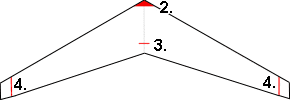Paper plane
This is probably the most efficient paperplane you can make. It can fly slower than walking speed and seems to defy gravity. The shape shown here was scanned from a working model.
- Fold a piece of paper and cut out the shape.
- Place a weight at the nose of the plane.
- Make a crease to increase stiffness.
- Fold the wingtips up at a 90 degree angle.
Folding the paper ensures that the plane you cut out is symmetrical, but the actual shape is not critical. The wingspan of this plane was 19 cm. If it gets much larger, then it will not be stiff enough to fly well. To make it stiffer I put a crease at the back of the plane. Finding the right weight for the nose of the plane is vital for the balance. A toothpick is a good place to start. If it nosedives then take off some of the weight, if it stalls and falls down then add some more weight. Folding the wingtips at a 90 degree angle usually helps the stability.
By adjusting the weight and/or the crease it will always be possible to get the plane to fly well. A well built plane can fly 8 meters without any visible loss of height. Paper reacts to changes in humidity by changing its shape, so if you hold it to hard in your hand too long it could affect the plane's ability to fly well. Let it rest under a book for some time to make it nice and flat again.

